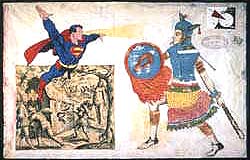 From the LA Times, 6/3/01:
From the LA Times, 6/3/01:The Many Masks of Aztlán
Though some don't buy it, the myth of an ancient homeland has become a favored metaphor among many Mexican Americans. Today, it's less a point on the map than a way for the present to intersect with the past.
By REED JOHNSON, Times Staff Writer
It was Eden and Atlantis rolled into one. A Shangri-La where old age and death supposedly were unknown. A paradise that, inscribed in ancient tribal memory, has passed from legend into tradition into myth.
Nearly every world culture has its epic of origin, a story that explains where its people came from and defines who they are. The Israelites had their Exodus, the Romans their "Aeneid," the Germans their Nibelungenlied.
For many Mexican Americans, this ethnic-genesis myth centers on Aztlán, the ancestral homeland of the great Aztec empire that ruled central Mexico before the Spanish conquest of 1519. Invoked by the Aztecs to justify their territorial claims, seized on by gold-hungry conquistadors as a road map to rumored riches, and embraced centuries later by the fledgling Chicano movement as proof of its people's right to be in the United States, Aztlán has worn many masks. Like an underground hot spring, its influence has coursed through Southwestern culture on both sides of the border for more than a millennium.
Now it has bubbled up again, this time in a major exhibition at the Los Angeles County Museum of Art that traces its history from pre-Columbian and colonial times to the present. That Aztlán even could be the subject of a major L.A. museum show is both a nod to Southern California's emerging Latino majority and a tribute to the potency and persistence of a centuries-old idea. Like any allegory worth its salt, Aztlán has been able to add new shades of meaning over time, incorporating and adapting to shifts in Mexican American culture. Though its force as a political symbol has declined as "El Movimiento Chicano" slides into middle age, it remains, beyond its poetic, nomadic imagery, a cultural touchstone that has once more galvanized discussions of what it means to be a Mexican-born American or Chicano (a person of Mexican descent born in the United States).
"Aztlán kind of functions like the bellybutton of an umbilical cord," says Reynaldo F. Macias, director of UCLA's Cesar E. Chavez Center for Interdisciplinary Instruction in Chicana & Chicano Studies. "It's kind of like where you're connected to, where you come from. At one time it kind of gets cut and you develop your own bellybutton, but you still know that you're connected. And there have been many progeny from that."
Indeed there have. Look around contemporary America and you'll find Aztlán in poetry, novels and essays. In paintings, murals and tattoos. In the name of an L.A. trucking company and in last month's downtown Chicano post-punk jamboree Aztlán Fest 2001.
In the tiendas of Broadway and the halls of Cal State Northridge, Aztlán has become a favored metaphor for many Mexican Americans trying to interpret, reweave and otherwise make sense of their cultural identity. And though some deride it as naive, propagandistic or simply passe, others regard Aztlán as a vital living metaphor that can be utilized in art, academia, cultural criticism and even public policy.
"We are a balloon ready to fly off; Aztlán is the anchor that keeps us grounded," says Gilbert "Magu" Sanchez Lujan, 61, an artist whose mixed-media work "Trailing Los Antepasados (Trailing the Ancestors)" is included in LACMA's show.
Scholars still debate Aztlán's actual location. Was it somewhere east of San Diego? In the Anasazi terrain of the Southwest? Maybe even (would you believe) China? Yet Aztlán today exists less as a measurable geographic entity than as an allegorical site transcending physical space, a landscape where myth, history and personal experience intersect.
And like most hybrids of fact and fantasy, Aztlán's legacy is not without question marks and controversy—a testament to its staying power. Jose Fuentes-Salinas, 44, a psychologist and cultural correspondent for the Spanish-language daily La Opinion, sees Aztlán as a cultural cliche that smacks of an outmoded and restrictive worldview.
Growing up in his hometown of Zacapu, in the Mexican state of Michoacan, "We had many influences—John Wayne movies, Gary Cooper movies, the Beatles, Eric Clapton . . . mixed with the Mexican culture of course, with cumbias, with the rancheras," Fuentes-Salinas says. "We got here [the United States] and we had a tag that you're not supposed to represent anything but mariachis, tacos and folk art. And that's stupid."
Aztlán, he believes, is symptomatic of such retrograde reasoning.
"When you notice that you lost something, it's a psychological reaction trying to idealize some of the past," he says. "There's a quote of the poet Jaime Sabines which says, 'For your future I don't wish you anything; I wish you could build a good past.' "
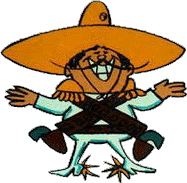
An Alternate History That Resonates
Thirty or 40 years ago, when the Chicano movement took wing, a good past looked infinitely better than the present. Aztlán's rediscovery by Chicanos came at a time when Mexican Americans were generally treated as second- or even third-class citizens in the United States. What few pop-culture representations existed were mostly grotesque, racist caricatures. Many Mexican American parents shied away from teaching Spanish to their first-generation U.S. offspring, fearing it might hinder them from entering Anglo America.
Aztlán reawakened in many Chicanos a sense of legitimacy and belonging. If their ancestors had migrated from the Southwestern United States, how could they themselves be considered "aliens"? It represented a kind of alternative reality to the Euro-centered national epic of origin that included Red Eric, Christopher Columbus, Plymouth Rock and Manifest Destiny. Today, for many, that alternative history still resonates.
"A theme or a cultural entity like Aztlán must be transformed by every generation," says Amalia Mesa-Bains, a Bay Area artist whose work appears in LACMA's show and director of the Institute for Visual and Public Art at Cal State Monterey Bay.
Central to Aztlán's present-day resonance is the notion of mestizaje, or ethnic mix. The concept was memorably articulated by Jose Vasconcelos (1882-1959), the Mexican education minister who spearheaded that country's post-revolutionary cultural renaissance in the 1920s and 1930s and became an intellectual godfather of Chicanismo.
In his seminal 1925 essay, "La Raza Cosmica: Mision de la Raza Iboamericana" (The Cosmic Race: Mission of the Ibo-American Race)," Vasconcelos envisioned a future utopia inhabited by the "definitive race, the synthesis of all races, the integrated race, built out of the genius and with the blood of all people, and, therefore, capable of true fraternity and universal vision."
Victor Zamudio-Taylor, co-curator of LACMA's exhibition, says that Aztlán's themes of ethnic intermingling, group wanderlust and dispersion, as well as the blurring of national borders and a cyclical view of history, spanning across time, mirror the 21st century mind set.
"More than a political myth," he says, "Aztlán [has become] a myth that embeds popular culture and intellectual culture and artistic culture as it relates to postmodernism, if postmodern society is characterized by high technologies, rapid communication, easy travel, the global village, and also the idea that many philosophies or traditions are in crisis."
But others question Aztlán's relevancy in a society that has changed considerably since Chicanismo's heyday 30 years ago. "You have to keep in mind how marginal these ideas were even at their height," says Gregory Rodriguez, 34, an essayist whose writing frequently appears in The Times, and a senior fellow at the New America Foundation, a nonpartisan public policy institute in Washington, D.C. "Go to Baldwin Park tomorrow and see how many people identify themselves as Chicano."
Rodriguez regards Chicanismo in general as stuck in a baby boomer time warp, replaying old issues. He compares the Chicano movement's appropriation of Aztlán with Italian Americans' appropriation of Christopher Columbus. Both cases, he says, illustrate "a very American process of digging your feet in a little deeper," establishing one's place in the larger society. But this rite of passage begins to recede as groups assimilate into the existing culture and form new hybrid cultures.
"Chicano iconography was a manifestation of alienation from both Mexican and American culture," Rodriguez says. "So in a sense, the need for such iconography today has lessened because there is a vital living culture here in Los Angeles. Today there's not as much of a need to contrive a mythical idea because there's an actual identity."
A Mesoamerican 'Star Wars'?
Legend holds that Aztlán was somewhere north of the Gulf of California, near or within a large body of water, and surrounded by seven caves. In the indigenous tongue of Nahuatl, it means, variously, "place of whiteness" or "land of the white herons." According to pre-Columbian beliefs, Aztlán was the Aztecs' home base until around the 11th century, when their war god, Huitzilopochtli, urged the tribe to migrate south. Some 200 years and several thousand miles later, their descendents, fulfilling an ancient prophecy, founded the imperial capital of Tenochtitlan, present-day Mexico City.
Sketchily documented and mostly anecdotal, Aztlán's physical boundaries are still much in question. In pre-Hispanic times, emperor Moctezuma Ilhuicamina sent emissaries north to seek out his peoples' ancestral homeland. The official map attached to the Treaty of Guadalupe Hidalgo, which ended the 1846-48 war between Mexico and the United States, includes a reference to the "Ancient Home of the Aztecs," which the New York map-maker situated near what is now southern Utah.
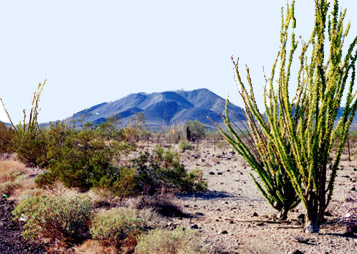
Some historians and anthropologists place Aztlán near the Four Corners area of New Mexico and Arizona. Others claim it sat beside what is now the Salton Sea, where periodic surging of the Colorado River once fed a verdant flood plain akin to the ancient Nile Delta. Still others assert that Aztlán never physically existed, that it's merely a fable, a kind of Mesoamerican "Star Wars" used to console a conquered race.
Whatever and wherever it was—or wasn't—the questions surrounding Aztlán's shadowy location and ambiguous fate seem to enhance its mystique. "It has lasted all these years as an aperture because it is so porous, so possible. There's not even an icon for it. You cannot even make an image of Aztlán," says artist Mesa-Bains.
Enrique Chagoya, 47, another Bay Area artist whose work is included in LACMA's exhibition, says that Aztlán probably wasn't as prominent a part of his upbringing in Mexico City as it has been for many U.S. Chicanos. "In Mexico, it was more like a history issue, something for the scholars to talk about. And in a way it was, because in Mexico the identity was safe: You didn't have to prove that you were coming from there. We already tended to identify as a nation with the pre-Columbian past."
Even so, Aztlán's influence can be detected in Chagoya's work, "Uprising of the Spirit," a 1994 acrylic and oil painting that scrambles time and cultural mythologies by juxtaposing U.S. pop culture iconography (in the form of Superman) with an equally iconic Indian warrior and a brutal image depicting the Spanish "encounter" with the New World.
"Aztlán was a way you could identify with a larger group, a community that becomes your network of friends," Chagoya says. "Even though for me the idea of Aztlán being part of the Southwest isn't accurate, the idea of it is important for the survival of the community."
Chon Noriega, 39, a UCLA associate professor in critical studies, says the Aztlán paradigm is mutating as new generations of scholars reexamine it. "Maybe we're at a point where there isn't a dominant way to characterize Chicano culture in general," says Noriega, who edits the academic journal Aztlán. "I think maybe you have several competing models."
Docu-Comedy Goes 'In Search of Aztlán'
In a small screening room six stories above Hollywood's sidewalks, the unearthing of Aztlán continues apace. Jesus Trevino's excavations began many years ago.In 1969, as an aspiring filmmaker, he recorded the National Chicano Youth Liberation Conference in Denver, where student activists laid out a Chicano civil rights, economic and political agenda under the title "El Plan Espiritual de Aztlán."
"It was at that conference we decided the driving ideology for the Chicano movement should be Aztlán," says Trevino, 52, whose soft-spoken demeanor masks a forceful intellect. "That was a very seminal movement because that's when we decided, 'We're second-class citizens, but our ancestors were here before other people were here.' "
These days Trevino is carving time away from his role as co-executive producer of the Showtime drama series "Resurrection Blvd." to produce "In Search of Aztlán," an hourlong "docu-comedy" starring the popular L.A.-based Chicano performance troupe Culture Clash. Shifting between metaphysical slapstick and probing interviews with historians, anthropologists, community activists and union leaders, the documentary makes a credible case for Aztlán's historic reality while adding a suitably postmodern, pop-culture spin.
Its viewpoint is perhaps best summarized near the end, in an interview with Rudolfo Anaya, the acclaimed novelist ("Bless Me, Ultima") and University of New Mexico professor. "The myth of Aztlán belongs to the people," Anaya says. "It doesn't have to be understood rationally. It's understood in the heart."
Richard Montoya of Culture Clash frames the issue similarly, though he is slightly more tongue in cheek. "Where do we find Aztlán?" he asks. "If you open up the Thomas Guide, you can't find it. In our quest to kind of hang our hat somewhere we've gone in search many times for Aztlán in our work and have played with the idea. Is it 40 acres in Delano, California, where Cesar Chavez started the United Farm Workers union? Is it in La Paz, where he's buried? Where is our mecca? Whether you're Jewish, African American, Mexican or Chicano, where is your mecca?"
Among Chicanos, Montoya believes, Aztlán's significance is now largely metaphorical. It is taken literally mostly by conservative non-Latinos fearful of what some have dubbed "the browning of America."
"It's a misinterpretation," Montoya says, "and it certainly is a carryover of the anti-immigrant hysteria that we saw during Pete Wilson's reign and Proposition 187, that we're going to create a nation and exclude everybody and take over busboy jobs and dishwashing jobs and we're basically going to take over the San Fernando Valley and parts of L.A. and create this nation. I know there may be some in the extreme left who may want to do that. But for the majority of Chicanos and Mexican Americans, I know the yearning is more spiritual. Middle-class Mexicans are not willing to leave their communities to go create Aztlán."
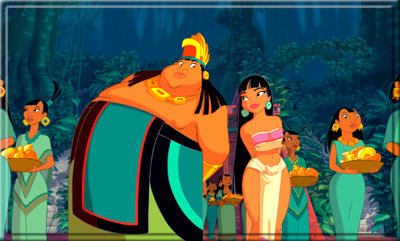
Fun-House Landscape Fuses Past, Present
Collapsing space and time into one hallucinatory image, the landscape is an eye-tickling cartoon fantasia. Mythic birds soar. A plumed god zips by on what looks like a serpentine skateboard. Candy-colored Aztec pyramids dot a highway linking present-day Los Angeles with pre-Columbian Mexico, bisected by a barbed-wire fence. In the lower right corner, a middle-age boxer fixes the viewer with an unsettled gaze.
It's a portrait of the artist himself, Gilbert "Magu" Sanchez Lujan—college teacher, Pomona resident and founding figure of the Chicano art movement of the 1960s and '70s. The fun-house landscape in which Magu has chosen to situate himself is a dynamic, studiedly irreverent fusion of past and present, the home-grown and the imported, historical reality and resonant myth.
It is, of course, Aztlán, a place Magu views from duel perspectives. His vibrant visual lexicon of temples, gods and mythical beasts evokes the homeland's dynamism. But Magu's disarming humor deflates any romantic visions of indigenous life the viewer may harbor.
"I have a contradictory thing going on," says Magu, showing a visitor around his 1,500-square-foot studio. "I'm paying homage to the past, but I'm not so hooked up to it that I can't make fun of it a little bit."
Like the works of several other artists in LACMA's exhibition, Magu's is a more oblique, poetic and indirect response to Aztlán than the militant, agitprop imagery associated with Chicanismo's first flowering. These are visions of Aztlán as a personal, interior landscape. There's a free-ranging interplay of symbols and ideas, such as might be experienced in life by the increasing numbers of Mexican Americans who hold two passports.
"For those people [dual citizens] you no longer have a country, in a way, that has borders," says artist Chagoya. "You have a borderless country. The world kind of becomes your country, in a way you never thought about before. But you still need a country, to have your ground, or at least to have some sense of community, belonging, without being nationalistic, chauvinistic. It's more a matter of being proud of yourself, being happy for yourself."
Aztlán, a story about wandering and arriving, has come far from the 1960s. It is equally far from the calendar-art cliches of bronzy Aztec princes and bare-breasted princesses cavorting in the moonlight.
Perhaps the road to Aztlán can still lead us further into that borderless country of the imagination, a place where the present shakes hands with the past and neither ethnicity nor geography is destiny.
Copyright © 2001 Los Angeles Times
Rob's comment
Note the many references to pop cultural icons: Shangri-La, Superman, Star Wars, etc. They show how the myths of the "ancients" and present-day myth-making—books, movies, TV, cartoons, comics, etc.—are intertwined in people's thinking. Modern media forms are essentially updates of the age-old tradition of storytelling around a campfire.
Here's an expanded version of my Indian Comics Irregular essay Superman vs. the Mexica:
In his paintings, Chicano artist Enrique Chagoya juxtaposes pop cultural references with imagery from pre-Columbian and colonial Mexican sources. In particular, he uses comic book and cartoon characters: Superman, Spider-Man, even Mickey Mouse. The result is a revealing clash of titans.
A museum website describes Chagoya's 1994 painting Uprising of the Spirit:
Superman, an American cultural icon, has just left a scene of carnage between Spanish conquistadores and the Mexica. His X-ray vision is now focusing on an image of the king, as they prepare to battle.
Chagoya says he's not sure what his artwork means, but it seems clear to me. Superman flies from an old drawing showing Europeans burning a house with its victims inside. His super-breath could've put out the fire; his heat vision could've started it. Now Superman faces the Mexica king in a grudge match between Western imperialism and indigenous resistance. Each side's ultimate warrior is ready to fight for the Mexican—and the world's?—soul.
Even the choice of weapons is perfect. The Indian king uses sword and shield made of bone and hide. The American hero uses unstoppable radioactive rays. In small doses these rays reveal hidden danger; in large doses they cause cancer.
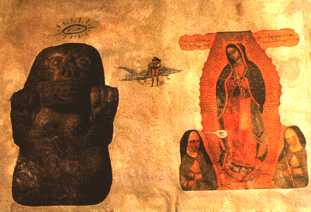
A panel of another Chagoya work, Insulae Canibalium (Cannibal Island), is even more suggestive. On the left is a large image of the Aztec goddess Cihuateto—a woman with a skull head. On the right is an equally large image of the Virgin of Guadalupe, with two nuns at her feet. One nun has a word balloon saying "Beat you." In the middle is the tiny figure of Wonder Woman standing before her robot plane, hands on hips, looking confident.
Nature's twin extremes—death and life—loom over the Amazon warrior. She's bold and fearless, but doesn't have a clue about the powerful forces around her. Like other Western figures, she'll tackle problems with strength and technology while ignoring the human and spiritual dimensions.
(For those who don't know, the Virgin of Guadalupe is revered by Mexico's Indian people as one of their own. They've incorporated her into their pantheon, making her an indigenous goddess as well as mother of the Christian God. Wonder Woman is closely linked to Greek goddesses such as Athena, Aphrodite, and Hera. Even Chagoya may not know she was briefly a real goddess in her comic.)
The battle lines are drawn: A Greek/Western/American goddess vs. two Mexican/indigenous/earth goddesses. The nun makes it plain this is a fight for supremacy, not merely a staring contest, when she utters the memorable "Beat you." Judging by their relative proportions, the indigenous goddesses have the superior position. Their beliefs and values will surely win.
Elsewhere in Cannibal Island, Chagoya places Superman, Batman, and Spider-Man on the perimeter, reacting to indigenous images. They're confused, surprised, or impressed by the wonders they see. Though they're paragons of Western culture, they've found something beyond their ken.
In short, the West doesn't have all the answers, though it would like to think otherwise. The ancient, timeless traditions of Native cultures are deep with meaning. As Oren R. Lyons (Onandaga) put it in Exiled in the Land of the Free, the history of the Americas is like an iceberg:
[S]even-eighths lie beneath the surface of the water. We can see Western occupation above the surface of the water. The aboriginal people's time is below the surface and invisible. This 500-year occupation by Western man contrasts with the conservative estimate of 12,000 years of aboriginal occupation.
Or as Chief Seattle reportedly said to Governor Stevens in 1855:
When the last red man shall have perished, and the memory of my tribe shall have become a myth among the white man, these shores will swarm with the invisible dead of my tribe, and when your children's children think themselves alone in the field, the store, the ship, upon the highway, or in the silence of the pathless woods, they will not be alone.
Chagoya renders the invisible visible with his colorful, graphic icons. His choice of comic book characters is inspired. As I've said before, the superhero is a mythological avatar for today's America. He's an update of previous American heroes: the explorer, the pioneer, the cowboy (John Wayne).
The goal of these heroes was and is to spread Western civilization, establish law and order, and vanquish troublemakers in the way. In the cowboy's case, that meant Indians, rustlers, and other varmints. In Superman's case it means Luthor, Brainiac, and Doomsday. The method used is brute force—or as Teddy Roosevelt put it, "It is only the warlike power of a civilized people that can give peace to the world."
In comic books, heroes always win. In history books, they often lose. As in Greek plays, enlightenment comes from tragic loss and true humility. It's a lesson Jesus, Buddha, and Coyote taught but many have yet to learn.
Chagoya is urging us to recognize and reconsider our cultural conflicts. Can the techno-warrior really defeat, well, God, Mother Nature, and their representatives? The Bible says the meek shall inherit the earth; the Ghost Dancers believed "we shall live again." The question is whether we can acknowledge and adopt these attitudes before "progress" destroys us all.
More on Chagoya
Chagoya overview
Related links
Bits of History Suggest Utah is Location of Mythic Aztlan
Technology vs. Native values
Were the Aztecs murdering "animals"?
Native vs. non-Native Americans: a summary
Readers respond
"[T]he Latino culture is still there and intact, with the same Aztlan spirit or mindset...."
|
. . . |

|
All material © copyright its original owners, except where noted.
Original text and pictures © copyright 2007 by Robert Schmidt.
Copyrighted material is posted under the Fair Use provision of the Copyright Act,
which allows copying for nonprofit educational uses including criticism and commentary.
Comments sent to the publisher become the property of Blue Corn Comics
and may be used in other postings without permission.